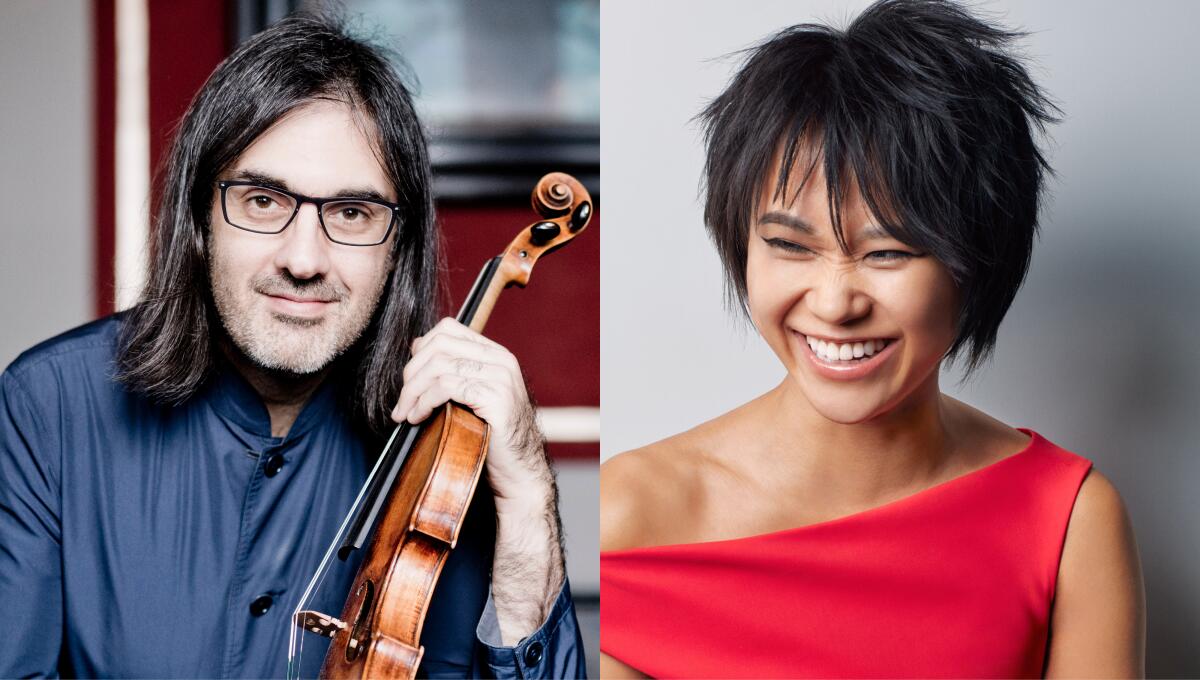Review: Star pianist Yuja Wang and celebrated violinist Leonidas Kavakos team up for a transfixing recital

- Share via
The violin and piano recital has not always been treated as a meeting of equals. The violinist traditionally gets first billing. The pianist has until only recently been referred to as an “accompanist,” and the piano lid is kept closed lest the “soloist” be drowned out. Although the keyboard’s role varies by historic period and composer, this hierarchy is becoming to feel outdated, whatever the original demands of the music.
When celebrated Greek violinist Leonidas Kavakos and star Chinese pianist Yuja Wang appeared together in a program of violin sonatas by Bach, Busoni and Shostakovich at Walt Disney Concert Hall on Thursday night, Kavakos still got first billing — they are violin sonatas, after all, and the repertory is his. But the piano lid remained up. And it is a good bet that Wang’s name on the program sold more tickets than did Kavakos’.
The musicians’ dynamic has matured since they starting performing as a sometime duo several years ago. The 54-year-old Kavakos may have once served as an informal chamber music mentor for Wang, 20 years his junior. In their 2014 recording of Brahms violin sonatas, the mercurial violinist dances around the more literal pianist, who lets her big Brahms sound reign while still subtly shaping the interpretation. It works.
At a recital three years later in Santa Barbara, Wang was noticeably on edge, thrown off by a page turner fumble. She played brilliantly, even ferociously, but as if she may have had still something to prove.
At Disney Hall, Wang was fully in her element. Clearly the sonatas were chosen, at least to some degree, for their substantial piano parts. Bach and Busoni were known to have been extraordinary piano players who wrote some of the most advanced and important keyboard music of their times. Although not known for playing Bach and Busoni in public, Wang has made a specialty of Shostakovich’s piano concertos, and the composer wrote the piano part of his Violin Sonata for no less than legendary Russian pianist Sviatoslav Richter.
Kinetic as Wang may be, neither she nor Kavakos is a particularly demonstrative performer; both are all business onstage. They often suggest the imperturbable spontaneity of jazz musicians reacting to one another. Intense and serious, they remarkably confronted the extraordinary power of these Busoni and Shostakovich sonatas that approach life as a grand and inescapably somber enterprise. When gloom is wanted, Wang and Kavakos can provide it. When overcoming gloom is needed, they convey that even better.
Coronavirus may have silenced our symphony halls, taking away the essential communal experience of the concert as we know it, but The Times invites you to join us on a different kind of shared journey: a new series on listening.
Each half of the program began with a Bach violin sonata (the third at the beginning, the first after intermission). Kavakos’ tone was thin, and he used little vibrato, doing a good job of imitating the 18th century manner. Even his intonation was slightly (and clearly intentionally) off, in this evoking the tuning systems of Bach’s day. Wang did not follow suit in trying to make the piano sound small or harpsichord-like; she played with a luminous clarity that Kavakos appeared to so enjoy that, entranced, he at times stayed in the background.
The Busoni and Shostakovich sonatas are worlds onto their own. Busoni wrote his at the turn of the 20th century, when he was a young composer with visionary intent. He approached Bachian counterpoint, late Beethoven spirituality and the new experiments in atonality happening in Berlin, where he lived, with a sense of making music matter for the future.
He also had a wild side that showed itself in an Italian dance that whirls off the rails in the middle movement. Here, Kavakos added a vibrato-rich tone while maintaining the same sense of adventure he brings to Bach. Wang went to town with the meaty piano part. The sonata ends with a massive movement that wends its way through colorful variations on a Bach chorale tune before trilling itself, in Beethoven’s manner, into a spiritual realm. Together, Kavakos and Wang were transfixing.
In Shostakovich’s earthier sonata, the somberness competes with the grotesque. For Kavakos, that meant becoming grippingly theatrical, yet without a trace of showiness. Wang found herself in her percussive element while also avoiding the temptation for exaggeration. Together, they let the Russian composer be, each performer enhancing the other. Style and substance became extraordinarily one.
Even so, style matters to Wang when it comes to her image. She no longer allows photography of her performances without approval (which violates The Times’ policy). For those who are wondering, she wore two now familiar black outfits; he, a suit and bowtie.
More to Read
The biggest entertainment stories
Get our big stories about Hollywood, film, television, music, arts, culture and more right in your inbox as soon as they publish.
You may occasionally receive promotional content from the Los Angeles Times.












